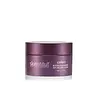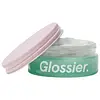What's inside
What's inside
 Key Ingredients
Key Ingredients

 Benefits
Benefits

 Concerns
Concerns

 Ingredients Side-by-side
Ingredients Side-by-side

Water
Skin ConditioningMacadamia Integrifolia Seed Oil
Skin ConditioningDimethicone
EmollientGlycerin
HumectantEthylhexyl Palmitate
EmollientPersea Gratissima Oil
Skin ConditioningCetearyl Olivate
Sorbitan Olivate
EmulsifyingCanola Oil
EmollientCetearyl Alcohol
EmollientCetyl Palmitate
EmollientBenzyl Alcohol
PerfumingSilica
AbrasiveSorbitan Palmitate
EmulsifyingZea Mays Starch
AbsorbentAmmonium Acryloyldimethyltaurate/Vp Copolymer
Niacinamide
SmoothingAloe Barbadensis Leaf Juice
Skin ConditioningDimethicone/Vinyl Dimethicone Crosspolymer
Skin ConditioningEthyl Olivate
EmollientOlea Europaea Leaf Extract
PerfumingParfum
MaskingAlpha-Isomethyl Ionone
PerfumingCitral
PerfumingCoumarin
PerfumingGeraniol
PerfumingLimonene
PerfumingLinalool
PerfumingCitric Acid
BufferingHydrolyzed Hyaluronic Acid
HumectantSodium Hydroxide
BufferingPanthenol
Skin ConditioningDehydroacetic Acid
PreservativeTerminalia Ferdinandiana Fruit Extract
AntioxidantHydrolyzed Beta-Glucan
Skin ConditioningDisodium EDTA
Sodium Benzoate
MaskingPotassium Sorbate
PreservativeWater, Macadamia Integrifolia Seed Oil, Dimethicone, Glycerin, Ethylhexyl Palmitate, Persea Gratissima Oil, Cetearyl Olivate, Sorbitan Olivate, Canola Oil, Cetearyl Alcohol, Cetyl Palmitate, Benzyl Alcohol, Silica, Sorbitan Palmitate, Zea Mays Starch, Ammonium Acryloyldimethyltaurate/Vp Copolymer, Niacinamide, Aloe Barbadensis Leaf Juice, Dimethicone/Vinyl Dimethicone Crosspolymer, Ethyl Olivate, Olea Europaea Leaf Extract, Parfum, Alpha-Isomethyl Ionone, Citral, Coumarin, Geraniol, Limonene, Linalool, Citric Acid, Hydrolyzed Hyaluronic Acid, Sodium Hydroxide, Panthenol, Dehydroacetic Acid, Terminalia Ferdinandiana Fruit Extract, Hydrolyzed Beta-Glucan, Disodium EDTA, Sodium Benzoate, Potassium Sorbate
Water
Skin ConditioningPhytosteryl/Isostearyl/Cetyl/Stearyl/Behenyl Dimer Dilinoleate
Skin ConditioningOrbignya Oleifera Seed Oil
EmollientGlycerin
HumectantPhytosteryl/Behenyl/Octyldodecyl Lauroyl Glutamate
Skin ConditioningTheobroma Grandiflorum Seed Butter
Skin ConditioningCetearyl Olivate
Glyceryl Stearate
EmollientCetearyl Alcohol
Emollient1,2-Hexanediol
Skin ConditioningLactobacillus Ferment Lysate Filtrate
Skin ConditioningSorbitan Olivate
EmulsifyingEthyl Linoleate
EmollientInulin Lauryl Carbamate
Emulsion StabilisingChlorella Vulgaris Extract
Skin ConditioningLeuconostoc/Radish Root Ferment Filtrate
AntimicrobialTocopherol
AntioxidantArginine
MaskingSclerotium Gum
Emulsion StabilisingPropanediol
SolventSorbitan Isostearate
EmulsifyingLactic Acid
BufferingDimethicone
EmollientHydroxyethyl Acrylate/Sodium Acryloyldimethyl Taurate Copolymer
Emulsion StabilisingHydroxyacetophenone
AntioxidantWater, Phytosteryl/Isostearyl/Cetyl/Stearyl/Behenyl Dimer Dilinoleate, Orbignya Oleifera Seed Oil, Glycerin, Phytosteryl/Behenyl/Octyldodecyl Lauroyl Glutamate, Theobroma Grandiflorum Seed Butter, Cetearyl Olivate, Glyceryl Stearate, Cetearyl Alcohol, 1,2-Hexanediol, Lactobacillus Ferment Lysate Filtrate, Sorbitan Olivate, Ethyl Linoleate, Inulin Lauryl Carbamate, Chlorella Vulgaris Extract, Leuconostoc/Radish Root Ferment Filtrate, Tocopherol, Arginine, Sclerotium Gum, Propanediol, Sorbitan Isostearate, Lactic Acid, Dimethicone, Hydroxyethyl Acrylate/Sodium Acryloyldimethyl Taurate Copolymer, Hydroxyacetophenone
 Reviews
Reviews

Ingredients Explained
These ingredients are found in both products.
Ingredients higher up in an ingredient list are typically present in a larger amount.
Cetearyl alcohol is a mixture of two fatty alcohols: cetyl alcohol and stearyl alcohol. It is mainly used as an emulsifier. Emulsifiers help prevent the separation of oils and products. Due to its composition, it can also be used to thicken a product or help create foam.
Cetearyl alcohol is an emollient. Emollients help soothe and hydrate the skin by trapping moisture.
Studies show Cetearyl alcohol is non-toxic and non-irritating. The FDA allows products labeled "alcohol-free" to have fatty alcohols.
This ingredient is usually derived from plant oils such as palm, vegetable, or coconut oils. There is debate on whether this ingredient will cause acne.
Due to the fatty acid base, this ingredient may not be Malassezia folliculitis safe.
Learn more about Cetearyl AlcoholCetearyl Olivate is an emulsifier and texture enhancer. It is derived from the fatty acids of olive oil and Cetearyl alcohol, and is biodegradable.
As an emulsifier, it is used to prevent oils and waters from separating. It can also
Manufacturers use the name Olivem 1000. This ingredient has been found to preserve the natural microbiome of skin. Having a healthy microbiome helps keep our skin healthy and protects against harmful bacteria. This ingredient is grouped with Sorbitan Olivate under the name Olivem 1000.
Learn more about Cetearyl OlivateDimethicone is a type of synthetic silicone created from natural materials such as quartz.
What it does:
Dimethicone comes in different viscosities:
Depending on the viscosity, dimethicone has different properties.
Ingredients lists don't always show which type is used, so we recommend reaching out to the brand if you have questions about the viscosity.
This ingredient is unlikely to cause irritation because it does not get absorbed into skin. However, people with silicone allergies should be careful about using this ingredient.
Note: Dimethicone may contribute to pilling. This is because it is not oil or water soluble, so pilling may occur when layered with products. When mixed with heavy oils in a formula, the outcome is also quite greasy.
Learn more about DimethiconeGlycerin is already naturally found in your skin. It helps moisturize and protect your skin.
A study from 2016 found glycerin to be more effective as a humectant than AHAs and hyaluronic acid.
As a humectant, it helps the skin stay hydrated by pulling moisture to your skin. The low molecular weight of glycerin allows it to pull moisture into the deeper layers of your skin.
Hydrated skin improves your skin barrier; Your skin barrier helps protect against irritants and bacteria.
Glycerin has also been found to have antimicrobial and antiviral properties. Due to these properties, glycerin is often used in wound and burn treatments.
In cosmetics, glycerin is usually derived from plants such as soybean or palm. However, it can also be sourced from animals, such as tallow or animal fat.
This ingredient is organic, colorless, odorless, and non-toxic.
Glycerin is the name for this ingredient in American English. British English uses Glycerol/Glycerine.
Learn more about GlycerinSorbitan Olivate is created from the fatty acids in olive oil and sorbitol.
This ingredient is an oil in water emulsifier. It helps stabilize a product by preventing oils and waters from separating. Sorbitan Olivate also helps hydrate the skin.
Manufacturers sell sorbitan olivate under the name OliveM 1000. OliveM 1000 a multifunctional ingredient. It is self-emulsifying. According to a manufacturer, OliveM 1000 does not disrupt natural skin biome.
Due to its olive oil base, this ingredient may not be fungal-acne safe.
Learn more about Sorbitan OlivateWater. It's the most common cosmetic ingredient of all. You'll usually see it at the top of ingredient lists, meaning that it makes up the largest part of the product.
So why is it so popular? Water most often acts as a solvent - this means that it helps dissolve other ingredients into the formulation.
You'll also recognize water as that liquid we all need to stay alive. If you see this, drink a glass of water. Stay hydrated!
Learn more about Water